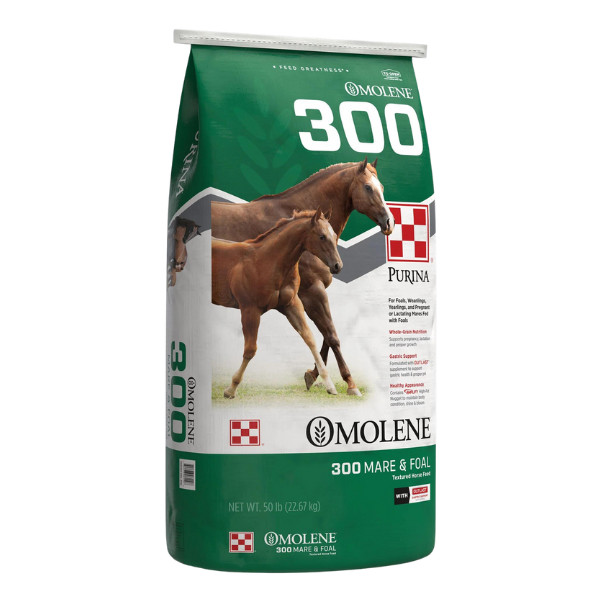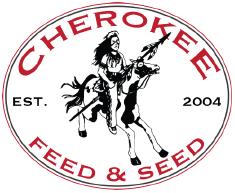Purina Omolene #300 Growth Horse Feed

When there’s greatness on the inside, it shows on the outside.
Purina Omolene #300 Growth Horse Feed is now formulated with Outlast Gastric Support Supplement.
It took over 100 years of industry-leading research and innovation to build today’s Purina Omolene horse feed lineup. We started with naturally nutritious high-quality whole grains packed with antioxidants, phytonutrients and prebiotic fibers. From there, countless nutrition studies and feeding trials at the Purina Animal Nutrition Center led to scientific breakthroughs that keep our formulas on the cutting-edge of equine nutrition and performance.
Because only innovations proven to have the highest level of performance and safety earn their place in Purina Omolene horse feeds. As a result, you can feed with full confidence. Omolene feeds are built to help solve your toughest nutritional challenges.
Stop into Cherokee Feed & Seed with two locations in Gainesville and Alpharetta, Georgia for your supply of Purina Omolene #300 Growth Horse Feed. Have questions? Be sure to contact us and a helpful member of our staff will guide you to the right horse feed for your equine. Learn more about the Omolene feed transition from Purina here.
Features
| FEATURES | BENEFITS |
| Concentrate Feed |
|
| Fortified with Milk Components |
|
| High Quality Protein |
|
| Natural Whole Grains |
|
| Purina® Amplify® High-Fat Nugget |
|
| Soy-Blend Molasses |
|
| Vitamin & Mineral Fortification |
|
Analysis
| CRUDE PROTEIN | MIN | 16.00 | % |
| LYSINE | MIN | 0.90 | % |
| CRUDE FAT | MAX | 6.00 | % |
| CRUDE FIBER | MIN | 6.50 | % |
| CALCIUM (CA) | MIN | 0.90 | % |
| CALCIUM (CA) | MAX | 1.20 | % |
| PHOSPHORUS | MIN | 0.55 | % |
| COPPER (CU) | MIN | 60 | PPM |
| SELENIUM (SE) | MIN | 0.60 | PPM |
| ZINC (ZN) | MIN | 220 | PPM |
| VITAMIN A | MIN | 3000 | IU/LB |
| VITAMIN E | MIN | 125 | IU/LB |
Directions
| - WEIGHT OF HORSE IN POUNDS - | |||||
| Lactating Mare | 600 | 800 | 1,000 | 1,200 | 1,400 |
| Minimum Hay or Equivalent Pasture* | 7.0 | 9.50 | 12.0 | 14.5 | 17.0 |
| Omolene #300® Horse Feed | 7.50 | 10.00 | 12.50 | 15.00 | 17.50 |
| - WEIGHT OF HORSE IN POUNDS - | |||||
| Weaned Foal Through Yearling | 300 | 400 | 500 | 600 | 700 |
| Minimum Hay or Equivalent Pasture* | 3.00 | 4.00 | 6.00 | 7.00 | 8.50 |
| Omolene #300® Horse Feed*** | 7.25-7.75 | 7.50-8.50 | 7.00-9.25 | 7.50-9.50 | 7.75-10.00 |
*These recommendations are based on the mare eating the minimum recommended amount of hay per day of 1.2 lbs per 100 lbs of
body weight. If feeding more hay, reduce the feeding rate of Omolene #300® Horse Feed by 1.0 lbs for every additional 2.0 lbs of hay fed.
EXAMPLE: Using the chart above, if feeding 16 lbs of hay to a 1,000 lb lactating mare, reduce Omolene #300® Horse Feed offered by 2.0
lbs from 12.5 to 10.5 lbs per day (4 lbs of additional hay divided by 2.0 lbs = 2.0 lbs less of Omolene #300® Horse Feed).
**Do not feed less than 0.5 lbs of Omolene #300® Horse Feed per 100 lbs of body weight per day for lactating mares. EXAMPLE: 5.0 lbs
for 1000 lb horse. Do not feed less than 1 lb of Omolene #300® Horse Feed per 100 lbs of body weight per day for weanlings. EXAMPLE: 6.0
lbs for 600 lb horse. If your horse gains too much weight at that minimum feeding rate, then you should replace Omolene #300® Horse Feed
with Purina’s Nature’s Essentials® Enrich 12® or Enrich 32® Horse Supplement.
***Adjust amount fed by 10% to achieve the desired growth rates. Increase feed offered by 10% for more rapid growth rates and
decrease by 10% for more moderate growth rates.
Important Considerations:
• Do not feed free-choice
• Feed at regular times (at least twice daily). When feeding rates exceed 1% of body weight, three daily feedings are preferred
• Any feed changes should be made gradually over a period of 7 to 10 days
• Changes in the rate of feeding should not exceed one pound per day for each horse
• Feed along with at least 1-1.5% of horse’s body weight of good quality hay or the equivalent in pasture to make a complete ration
• Have plenty of fresh, clean water available at all times
• Prevent the rapid eating by the horse of any feed stuffs
• Store feed in a dry, well-ventilated area protected from rodents and insects
• Do not feed moldy or insect-infested feed to animals as it may cause illness or death
• This product to be fed to the animal species as directed on the label
• In addition to nutritional care and consultation, be sure to make regular veterinary checkups and farrier appointments part of your horse wellness program
Contact Us
Navigation
- About
- Hay
- Products
- Store location
- Delivery Services
- Financing
- Specials
- Events
- News
- Contact
- Privacy Policy
